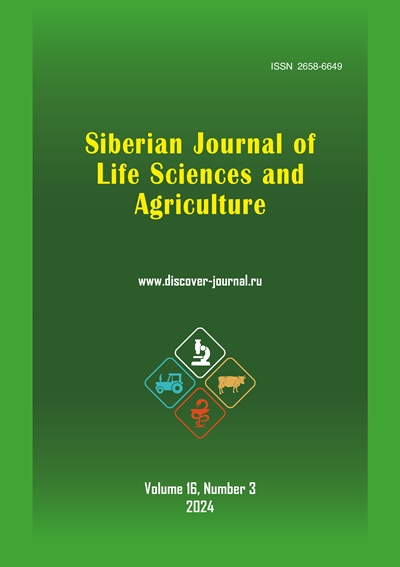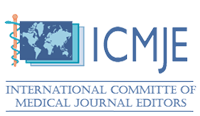ВЛИЯНИЕ ЭКСПЕРИМЕНТАЛЬНОЙ ИНВАЗИИ Т. PSEUDOSPIRALIS НА МОРФОЛОГИЮ СЕЛЕЗЁНКИ КУРИЦ (GALLUS DOMESTICUS)
Аннотация
Обоснование. Изучение реакции органов иммунной системы птиц при нематодозах является актуальным для разработки схем лечения. Разработаны многочисленные модели на лабораторных животных (мыши и крысы), на плотоядных (хори и др.) и птице (перепела, курицы). У последних паразитирует бескапсульный вид трихинелл, который имеет ряд особенностей воспроизведения. В настоящем исследовании была использована модель экспериментальной инвазии T. pseudospiralis. Изучена роль в формировании противонематодозного иммунитета селезенки и ее реакция на внедрение паразита у куриц (Gallus domesticus).
Целью проведенного исследования было изучение морфологических изменений в структуре селезенки при трихинеллезе, вызванном T. pseudospiralis у куриц в мышечную стадию инвазионного процесса.
Материалы и методы. Методом аналогов сформированы 2 группы по 6 голов. Птиц опытной группы взвешивали и внутрь зоба вводили изолят личинок T. pseudospiralis в дозе 2 лич./г массы тела. Личинки T. рseudospiralis, которых использовали для воспроизведения экспериментальной инвазии у птиц, были выделены из мышц кошачьих и птиц Дальнего Востока, и поддерживались на лабораторных животных и птицах в лаборатории ВНИИП-филиал ВИЭВ. Содержание и кормление всех куриц осуществляли в идентичных условиях. С целью определения распределения личинок в мышцах птицы T. рseudospiralis через 3,5 мес. после экспериментального заражения 6 куриц опытной группы подвергли эвтаназии. Птиц из эксперимента выводили в соответствии с «Правилами проведения работ с использованием экспериментальных животных» и в соответствии с принципами положения Хельсинкской декларации Всемирной медицинской ассоциации (Declaration of Helsinki, and approved by the Institutional Review Board). Определяли интенсивность инвазии (ИИ) по количеству личинок на грамм для каждой курицы и среднюю по группе и изучали особенности распределения личинок в срезе. Гистологические препараты селезенки готовили по классической методике (парафиновая проводка), с последующей резкой на ротационном микротоме и окраской гематоксилин – эозином.
Результаты исследований. После переваривания в искусственном желудочном соке мышечной массы количество личинок составило 2570+640 лич./г мышц (средняя ИИ от проб мышц исследуемых групп), в контрольной группе личинки трихинелл не обнаружены. Методом КТ наибольшая ИИ установлена в мышцах головы (5,5+1,5 личинок в срезе). Как и у млекопитающих, в селезенке здоровых и инвазированных птиц выявляется красная и белая пульпа, у здоровых птиц площадь красной пульпы составила 10±5% от площади органа, а белой пульпы 76,5±5%, от массы органа. У инвазированных личинками трихинелл куриц отмечали значительное увеличение площади белой пульпы (до 90% от площади органа и более).
Заключение. Селезенка куриц активно вовлекается в патогенез при гельминтозах птиц. Фолликулы белой пульпы, как и при трихинеллезе белых мышей разрастаются, сливаясь в крупные конгломераты. У птиц, также как и у млекопитающих, увеличивается количество больших лимфоцитов и плазмоцитов, что свидетельствует о схожести межклеточных взаимодействий и реакции иммунокомпетентных клеток на внедрение паразита.
Скачивания
Литература
Список литературы
Автандилов Г.Г. Медицинская морфометрия: руководство. М.: Изд. «Медицина», 1990. 384 с.
Асатрян А.М. Биологические и морфологические особенности Trichinella spiralis и T. pseudospiralis у различного вида хозяев: дисс… док. биол. наук. М., 1998 с.
Боляхина С.А., Ефремова Е.А. Сравнение морфологических изменений в крови кур при экспериментальном заражении Т. spiralis и Т. pseudospiralis // Теория и практика борьбы с паразитарными болезнями. 2023. № 24. С. 95-99.
Бритов В.А. Гельминты Дальнего Востока. Хабаровск, 1973. С. 19-22.
Бритов В.А. Возбудители трихинеллеза. М.: Наука, 1982. 272 c.
Гаркави Б.Л. Трихинеллез, вызываемый Тrichinella pseudospiralis (морфология и биология возбудителя, эпизоотология и эпидемиология, диагностика, меры борьбы и профилактика) // Российский паразитологический журнал. 2007. № 2. С. 35-116.
Гаркави Б.Л. Гельминтозоонозы: меры борьбы и профилактика. М., 1994. 50 с.
Жданова О.Б., Часовских О.В., Руднева О.В., Успенский А.В. К вопросу об изменении морфологии селезенки при нематодозах у мышей при иммуностимуляции // Siberian Journal of Life Sciences and Agriculture. 2023. Т. 15. № 3. С. 11-25. https://doi.org/10.12731/2658-6649-2023-15-3-11-25
Жданова О.Б., Распутин П.Г., Масленникова О.В. Трихинеллез плотоядных и биобезопасность окружающей среды // Экология человека. 2008. № 1. С. 9-11.
Мартусевич А.K., Жданова О.Б. Информативность исследования свободного кристаллообразования при зоонозах на модели лабораторных животных // Известия высших учебных заведений. Поволжский регион. 2006. № 1 (22). С. 30-39.
Мартусевич А.К., Жданова О.Б. Исследование зависимости кристаллогенной активности биосреды от интенсивности экспериментальной инвазии Тrichinella spiralis // Российский паразитологический журнал. 2013. № 2. С. 64-71.
Окулова И.И., Березина Ю.А., Бельтюкова З.Н., Домский И.А., Беспятых О.Ю. Иммуноморфологическое показатели сыворотки крови у представителей семейства Canidae после имплантации мелакрила // Siberian Journal of Life Sciences and Agriculture. 2021. Т. 13. № 5. С. 11-25. https://doi.org/10.12731/2658-6649-2021-13-5-11-25
Руднева О.В., Жданова О.Б., Клюкина Е.С., Написанова Л.А., Мутошвили Л.Р. Влияние комплексного иммунопрепарата на лимфоидную ткань, ассоциированную со слизистой оболочкой кишечника // Морфология. 2019. Т. 155. № 2. С. 243-244.
Сапин М.Р., Никитюк Д.Б. Иммунная система, стресс и иммунодефицит. М.: АПП «Джангар», 2000. 184 с.
Ставинская О.А., Добродеева Л.К., Патракеева В.П. Влияние некроза и апоптоза лимфоцитов на выраженность иммунных реакций // Siberian Journal of Life Sciences and Agriculture. 2021. Т. 13. № 4. С. 209-223. https://doi.org/10.12731/2658-6649-2021-13-4-209-223
Самчук М.Г., Панасенкова О.Г., Яковлева А.В., Яковлев А.А., Щелкунова И.Г. Клинический случай диагностики стронгилоидоза у пациента в хроническом критическом состоянии на фоне тяжелого поражения головного мозга // Siberian Journal of Life Sciences and Agriculture. 2021. Т. 13. № 1. С. 78-93. https://doi.org/10.12731/2658-6649-2021-13-1-78-93
Успенский А.В., Жданова О.Б., Андреянов О.Н., Написанова Л.А., Малышева Н.С. Трихинеллоскопия туш домашних и диких животных // Российский паразитологический журнал. 2021. Т. 15. № 3. С. 71-75.
Эпидемиологический надзор за трихинеллёзом: Методические указания. М.: Федеральный центр гигиены и эпидемиологии Роспотребнадзора, 2014. 26 с.
Boulos L.M., Samara L.A., Hagaz H.J.A. 8 Intern. Conf. of trichinellosis. Abstract book. Rom, 1995. P. 29.
Bruschi F., Pozio E., Watanabe N. et al. Inter. Archiv. of Allergy and Immunology. 1999. Vol. 119, № 4. P. 291-296.
Mestecky J. The common mucosal immune system and current strategies for induction of immune responses in external secretions // Clin. Immunol. 1987. № 7. Р. 265-276.
Jongwutiwes S., Chantachum N., Kraivichian P., Siriyasatien P., Putaporntip C., Tamburrini A., La Rosa G.F., Sreesunpasirikul C., Yingyourd P., Pozio E. First outbreak of human trichinellosis caused by Trichinella pseudospiralis // J. Clin. Infect. Dis. 1998. Vol. 26 (1). Р. 111–115.
Pozio E., La Rosa G., Rossi P., Murrell K.D. J. Parasitol. 1992. Vol. 78, № 4. P. 647-653.
Pozio E., Shaikenov B., La Rosa G., Obendorf D.I. Allozymic and biological characters of Trichinella pseudospiralis isolates from free-ranging animals // J. Parasitol. 1992. Vol. 78. P. 1087-1090.
Pozio E., Christensson D., Steen M., Marucci G. Trichinella pseudospiralis foci in Sweden // J. Vet. Parasitology. 2004. Vol. 125. P. 335-342. https://doi.org/10.1016/j.vetpar.2004.07.020
Ranque S., Fauge`re B., Pozio E., La Rosa G., Tamburrini A., Pellisier J. F., Brouqui P. Trichinella pseudospiralis outbreak in France // J. Emerg. Infect. Dis. 2000. Vol. 6 (5). P. 543–547.
Rudneva O.V., Napisanova L.A., Zhdanova O.B., Berezhko V.K. Evaluation of the protective activity of different immunostimulatory drugs at the experimental trichinosis on white mice // International Journal of High Dilution Research. 2018. Vol. 17. № 2. С. 17-18.
Shepherd C., Navarro S., Wangchuk P., Wilson D., Daly N. L., Loukas A. Identifying the immunomodulatory components of helminths // Parasite Immunol. 2015. Vol. 37 (6). P. 293–303.
Tahoun A., Mahajan S., Paxton E., Malterer G., Donaldson D.S., Wang D., Tan A, Gillespie T.L., O’Shea M., Roe A.J., Shaw D.J., Gally D.L., Lengeling A., Mabbott N.A., Haas J., Mahajan A. Salmonella transforms follicle-associated epithelial cells into M cells to promote intestinal invasion // Cell Host Microbe. 2012. Vol. 12, No. 5. P. 645–656. https://doi.org/10.1016/j.chom.2012.10.009
Zhdanova O.B., Haidarova A.A., Napisanova L.A., Rossohin D., Lozhenicina O. Тhe possibility of using trichinella spiralis as an experimental model in the field of high dilutions // International Journal of High Dilution Research. 2015. Vol. 14. № 2. P. 60-61.
Zhdanova O.B., Rudneva O.V., Akulinina Yu.K., Napisanova L.A. Еvaluation of the effectiveness of different immunostimulatory medicine at the experimental trichinosis and leishmaniosis on white mice // International Journal of High Dilution Research. 2019. Vol. 18. № 2. P. 12.
References
Avtandilov G.G. Medical morphometry: manual. Moscow: Izd. “Medicine”, 1990, 384 p.
Asatryan A.M. Biological and morphological features of Trichinella spiralis and T. pseudospiralis in different kinds of hosts. M., 1998 p.
Bolyakhina SA, Efremova EA Comparison of morphological changes in the blood of chickens during experimental infection with T. spiralis and T. pseudospiralis. Theory and practice of the fight against parasitic diseases, 2023, no. 24, pp. 95-99.
Britov V.A. Helminths of the Far East. Khabarovsk, 1973, pp. 19-22.
Britov V.A. Trichinellosis pathogens. Moscow: Nauka, 1982, 272 p.
Garkavi B.L. Trichinellosis caused by Trichinella pseudospiralis (morphology and biology of the causative agent, epizootology and epidemiology, diagnosis, control measures and prophylaxis). Russian Parasitological Journal, 2007, no. 2, pp. 35-116.
Garkavi B.L. Helminthozoonoses: control measures and prevention. М., 1994, 50 p.
Zhdanova O.B., Chasovskikh O.V., Rudneva O.V., Uspensky A.V. To the question of changes in the morphology of the spleen in nematodosis in mice with immunostimulation. Siberian Journal of Life Sciences and Agriculture, 2023, vol. 15, no. 3, pp. 11-25. https://doi.org/10.12731/2658-6649-2023-15-3-11-25
Zhdanova, O.B.; Rasputin, P.G.; Maslennikova, O.V. Trichinellosis of carnivores and biosecurity of the environment. Human ecology, 2008, no. 1, pp. 9-11.
Martusevich A.K., Zhdanova O.B.. Informativeness of the study of free crystal formation in zoonosis on the model of laboratory animals. Izvestiya vysokikh uchebnykh uchebnykh obrazovaniya. Volga region, 2006, no. 1 (22), pp. 30-39.
Martusevich A.K., Zhdanova O.B.. Study of the dependence of the crystallogenic activity of the biosphere on the intensity of experimental invasion of Trichenella spiralis. Russian Parasitological Journal, 2013, no. 2, pp. 64-71.
Okulova I.I., Berezina Yu.A., Beltyukova Z.N., Domsky I.A., Bespyatykh O.Yu. Immunomorphologic indices of blood serum in representatives of the family Canidae after implantation of melacryl. Siberian Journal of Life Sciences and Agriculture, 2021, vol. 13, no. 5, pp. 11-25. https://doi.org/10.12731/2658-6649-2021-13-5-11-25
Rudneva O.V., Zhdanova O.B., Klyukina E.S., Nicanova L.A., Mutoshvili L.R. The effect of complex immunopreparation on the lymphoid tissue associated with the intestinal mucosa. Morphology, 2019, vol. 155, no. 2, pp. 243-244.
Sapin M.R., Nikityuk D.B. Immune system, stress and immunodeficiency. Moscow: APP “Dzhangar”, 2000, 184 p.
Stavinskaya O.A., Dobrodeeva L.K., Patrakeeva V.P. Effect of necrosis and apoptosis of lymphocytes on the severity of immune responses. Siberian Journal of Life Sciences and Agriculture, 2021, vol. 13, no. 4, pp. 209-223. https://doi.org/10.12731/2658-6649-2021-13-4-209-223
Samchuk M.G., Panasenkova O.G., Yakovlev A.V., Yakovlev A.A., Shchelkunova I.G. Clinical case of strongyloidiasis diagnosis in a patient in chronic critical condition against the background of severe brain damage. Siberian Journal of Life Sciences and Agriculture, 2021, vol. 13, no. 1, pp. 78-93. https://doi.org/10.12731/2658-6649-2021-13-1-78-93
Uspensky A.V., Zhdanova O.B., Andreyanov O.N., Nicanova L.A., Malysheva N.S. Trichinelloscopy of carcasses of domestic and wild animals. Russian Parasitological Journal, 2021, vol. 15, no. 3, pp. 71-75.
Epidemiologic surveillance of trichinellosis: Methodological guidelines. Moscow: Federal Center of Hygiene and Epidemiology of Rospotrebnadzor, 2014, 26 p.
Boulos L.M., Samara L.A., Hagaz H.J.A. 8 Intern. Conf. of trichinellosis. Abstract book. Rom, 1995, p. 29.
Bruschi F., Pozio E., Watanabe N. et al. Inter. Archiv. of Allergy and Immunology, 1999, vol. 119, no. 4, pp. 291-296.
Mestecky J. The common mucosal immune system and current strategies for induction of immune responses in external secretions. Clin. Immunol., 1987, no. 7, pp. 265-276.
Jongwutiwes S., Chantachum N., Kraivichian P., Siriyasatien P., Putaporntip C., Tamburrini A., La Rosa G.F., Sreesunpasirikul C., Yingyourd P., Pozio E. First outbreak of human trichinellosis caused by Trichinella pseudospiralis. J. Clin. Clin. Infect. Dis., 1998, vol. 26 (1), pp. 111-115.
Pozio E., La Rosa G., Rossi P., Murrell K.D. J. Parasitol. Parasitol., 1992, vol. 78, no. 4, pp. 647-653.
Pozio E., Shaikenov B., La Rosa G., Obendorf D.I. Allozymic and biological characters of Trichinella pseudospiralis isolates from free-ranging animals. J. Parasitol. Parasitol., 1992, vol. 78, pp. 1087-1090.
Pozio E., Christensson D., Steen M., Marucci G. Trichinella pseudospiralis foci in Sweden. J. Vet. Vet. Parasitology, 2004, vol. 125, pp. 335-342. https://doi.org/10.1016/j.vetpar.2004.07.020
Ranque S., Fauge`re B., Pozio E., La Rosa G., Tamburrini A., Pellisier J. F., Brouqui P.. Trichinella pseudospiralis outbreak in France. J. Emerg. Emerg. Infect. Dis., 2000, vol. 6 (5), pp. 543-547.
Rudneva O.V., Napisanova L.A., Zhdanova O.B., Berezhko V.K. Evaluation of the protective activity of different immunostimulatory drugs at the experimental trichinosis on white mice. International Journal of High Dilution Research, 2018, vol. 17, no. 2, pp. 17-18.
Shepherd C., Navarro S., Wangchuk P., Wilson D., Daly N. L., Loukas A. Identifying the immunomodulatory components of helminths. Parasite Immunol., 2015, vol. 37 (6), pp. 293–303.
Tahoun A., Mahajan S., Paxton E., Malterer G., Donaldson D.S., Wang D., Tan A, Gillespie T.L., O’Shea M., Roe A.J., Shaw D.J., Gally D.L., Lengeling A., Mabbott N.A., Haas J., Mahajan A. Salmonella transforms follicle-associated epithelial cells into M cells to promote intestinal invasion. Cell Host Microbe., 2012, vol. 12, no. 5, pp. 645–656. https://doi.org/10.1016/j.chom.2012.10.009
Zhdanova O.B., Haidarova A.A., Napisanova L.A., Rossohin D., Lozhenicina O. Тhe possibility of using trichinella spiralis as an experimental model in the field of high dilutions. International Journal of High Dilution Research, 2015, vol. 14, no. 2, pp. 60-61.
Zhdanova O.B., Rudneva O.V., Akulinina Yu.K., Napisanova L.A. Еvaluation of the effectiveness of different immunostimulatory medicine at the experimental trichinosis and leishmaniosis on white mice. International Journal of High Dilution Research, 2019, vol. 18, no. 2, p. 12.
Просмотров аннотации: 215 Загрузок PDF: 95
Copyright (c) 2024 Olga B. Zhdanova, Olga V. Chassоkikh, Aleksandr V. Uspensky

Это произведение доступно по лицензии Creative Commons «Attribution-NonCommercial-NoDerivatives» («Атрибуция — Некоммерческое использование — Без производных произведений») 4.0 Всемирная.






















































